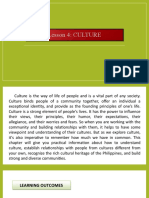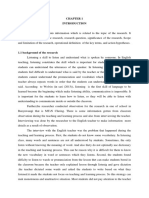Name Dhea Amanda NPM 1806102020075: Introduction To Culture
Name Dhea Amanda NPM 1806102020075: Introduction To Culture
Uploaded by
TrymescrubCopyright:
Available Formats
Name Dhea Amanda NPM 1806102020075: Introduction To Culture
Name Dhea Amanda NPM 1806102020075: Introduction To Culture
Uploaded by
TrymescrubOriginal Description:
Original Title
Copyright
Available Formats
Share this document
Did you find this document useful?
Is this content inappropriate?
Copyright:
Available Formats
Name Dhea Amanda NPM 1806102020075: Introduction To Culture
Name Dhea Amanda NPM 1806102020075: Introduction To Culture
Uploaded by
TrymescrubCopyright:
Available Formats
NAME; DHEA AMANDA
NPM; 1806102020075
Contents
Chapter 1.
Introduction to culture.
As a country we are apt to be guilty of great ethnocentrism. In many of our
foreign and aid programs we employ a heavy-handed technique in dealing with
local nationals. We insist that everyone else do things our way. Consequently we
manage to convey the impression that we simply regard foreign nationals as
‘’underdeveloped americans’’. Most of our behavior does not spring from malice
but from ignorance.. we are not only almost tottaly of what we are
communicating to other people by our own normal behavior.
Discussion of issues
We need to learn to observe behavior, including our own, more carefully. As we
assume, albeit often unconsciously, that our way is the ‘’normal’’, ‘’natural’’,
‘’right’’ way do the things. We tend to react at a good level to what we perceive
as offensive or negative. We are unware that what has offended us is not the
action of it self but the fact that the action violated some deeply held belief or
value. However we cannot all expect to become experts in every culture that
differs from our own.
Chapter 1 is concerned with the issues of culture in shaping our behavior,
attitudes, and perceptions of the world. The chapter explores the definitions of
culture, and the relationship between culture and language.
Theory: what research tells us
The concept of culture
Culture is pervasive, all-encompassing, and inescapable. The images and messag
we receive and transmit are profoundly shaped by our culture. It is the framework
through which we understand and interpret the world around us, in that it
provides the context for a group of people to understand and interpret the world
around them. Defining culture is not an easy task. Culture is a very broad concept
for which there is no single, simple definitions or central theory. Different fields of
study differ in their concept of culture, in their definitions of their culture, in their
methods of investigating culture, and in the focus of their cultural studies. The
many definitions given the concept of culture have been strongly influenced by
research in the fields of linguistic, antrophology, sociology, physchology, and
communication.
Defining culture
The term culture is a very general concept, composed of a complex system of
interaction elements. Culture is universal, multificated, and intricate. It is in all
aspects of human society; it penetrates into every area of life and influence the
way that people think, talk, and behave. Culture is not the characteristic of a
single individual but, rather, ‘’a collective mental programming of the people in
the environment’’. Culture can be viewed as a set of ideas, practice, and
experienced share by a group of people in an environment.
ENCULTURATION
By its very nature, culture is a teacher. It is a subconscious teacher of the bealief,
values, worldviews, and patterns of behavior members. The process of becoming
socialized into one’s culture begins early in the life, through what is known as
enculturation. Because culture is shared with people who lived in and the same
experience in the same social environment.
ELEMENTS OF CULTURE
BELIEFS
Beliefs are an individuals convictions about the world, convictions that are shaped
by the culture a person is raised in. How strongly individuals particular belief
depends on the degree to which individuals ascribe certain characteristic to that
belief. A belief that is held by most members of a culture is called a cultural belief
although among the group had a different culture but the meaning of what they
do is just the same with othet cultures.
VALUES
Values are ideals or abstract standards, wheter good or bad, that member of a
cultural group hold in strong affective regard. They are share assumptions or
judgments about what is good, right, and important.
NORMS
Norms are the fixed patterns for members of cultural group. They are culturally
shared notions about what is appropriate behavior.
TABOOS
Taboos are an important subset of mores. Taboos specify what is or is not
permissible. In their strongest form , taboos cover universal prohibitions such as a
murder and incest.
ATTITUDES
Attitudes are emotional reactions to object, ideas, people. People learns attitudes
within a cultural context. The cultural environment to which an individual is
exposed helps mold the individuals attitudes and ultimately, his or her behavior.
LANGUAGE AND LINGUISTIC RELATIVITY
Language and culture are intimately linked. Culture influences the way speakers
perceive the world and how they use language to communicate. Likewise,
language influences how speakers view the world and the way in which they are
communicate. How intricately linked are culture and language? The degree to
which language influences human thought and meaning is the termed linguistic
relativity.
CATEGORIZATION
All language use categories to organize the world around them. However, what is
included or excluded and how the categories are organized is to some extent
arbitrary and varies greatly among language. Every language has category to
describe mothet,father,son,daughter. Different language will make finer
distinctions between components in categoris that have important significance to
to the members of that culture.
LANGUAGE AND CULTURE
Language is an organized, learned symbol system used to represent human
experiences within a geographic or cultural group. Language reflects the
worldviews, the thought processes,and the lifestyle of its people; each culture
places it’s own individual imprint on a language. Language is the primary medium
for transmitting among its speakers culture’s belief, values, norms, worldviews.
TEACHING AND LEARNING CONNECTIONS
Culture is an integral part of language teaching and learning. As long as there are
speakers, there is culture, as culture resides in the user of an language. The goal
in education is ‘’to translate culture teaching into a culture learning experience
for our students’’. Teacher can work toward this goal through careful planning of
a classroom activities, which may reflect their own personal life experiences, and
by actually walking students through the variety stages of developing intercultural
awareness or cultural sensitivity.
You might also like
- Lesson Three Hair AppointmentDocument10 pagesLesson Three Hair AppointmentHassanNo ratings yet
- Voyage B2 CB Unit1Document13 pagesVoyage B2 CB Unit1Mym Madrid MymNo ratings yet
- Ucsp PortfolioDocument33 pagesUcsp PortfolioCasey keith Garcia0% (1)
- What Is Culture?Document4 pagesWhat Is Culture?Raja AhsanNo ratings yet
- Definition, Characteristics and Important Functions of Culture (Jaena&Parba)Document28 pagesDefinition, Characteristics and Important Functions of Culture (Jaena&Parba)Vergie Lyn Pioquinto JaenaNo ratings yet
- Important Characteristics of CultureDocument3 pagesImportant Characteristics of CultureRubelyn PatiñoNo ratings yet
- CULTUREDocument7 pagesCULTUREAnas idrees100% (1)
- CCD by GKDDocument46 pagesCCD by GKDYash JunejaNo ratings yet
- Literature Review On CultureDocument5 pagesLiterature Review On CultureAkash DasNo ratings yet
- Discussion #3: The Concept of Culture Learning ObjectivesDocument4 pagesDiscussion #3: The Concept of Culture Learning ObjectivesJohn Lery SurellNo ratings yet
- Firoiu 2012Document48 pagesFiroiu 2012Denisa MălăescuNo ratings yet
- UCSP - Module 1 - Lesson 3Document90 pagesUCSP - Module 1 - Lesson 3Pau B.100% (1)
- Ethics LM Lesson4Document5 pagesEthics LM Lesson4hazelNo ratings yet
- Lesson 4: CULTURE: Learning OutcomesDocument5 pagesLesson 4: CULTURE: Learning OutcomesClaudine Gratela GratilNo ratings yet
- Assignment 5 June 21 Nur MaykasariDocument3 pagesAssignment 5 June 21 Nur MaykasariNur MaykasariNo ratings yet
- Mac 851 NotesDocument10 pagesMac 851 Noteselsonsakala123No ratings yet
- List of ContentsDocument8 pagesList of ContentsMaria JBieber BrandonizerNo ratings yet
- CULTUREDocument6 pagesCULTUREstephyannie7No ratings yet
- Module 3 Culture in Moral BahaviorDocument32 pagesModule 3 Culture in Moral BahaviorJustin Paul Gallano100% (2)
- Module 2 Lesson 1 Culture in Moral BahaviorDocument47 pagesModule 2 Lesson 1 Culture in Moral Bahaviorzzrot1100% (1)
- CultureDocument2 pagesCulturetheirontemple03No ratings yet
- Anthropological Perspective of SelfDocument4 pagesAnthropological Perspective of Selfkrishelleanne.abobo.24No ratings yet
- NPR - KQED - Mindshift - How Awareness of Cultural Differences Can Help Underachieving StudentsDocument5 pagesNPR - KQED - Mindshift - How Awareness of Cultural Differences Can Help Underachieving StudentsRoger SalvadorNo ratings yet
- GEC8 - Culture and MoralityDocument54 pagesGEC8 - Culture and MoralityNica RomeroNo ratings yet
- Characteristics of Culture: @nicolegeliqueDocument28 pagesCharacteristics of Culture: @nicolegeliqueDaphne CalluengNo ratings yet
- ANTHROPOLOGYDocument40 pagesANTHROPOLOGYCarla Flor Losiñada100% (1)
- Cross Cultural Communication Module 1Document11 pagesCross Cultural Communication Module 1MALAY KUMAR100% (1)
- Unit 1.moocDocument11 pagesUnit 1.moocr.hatdogcheesedogNo ratings yet
- CROSS CULTURE LEADERSHIP NotesDocument112 pagesCROSS CULTURE LEADERSHIP NotesGunveen AbrolNo ratings yet
- Pop Culture PrelimDocument5 pagesPop Culture PrelimswingjnielsynNo ratings yet
- Culture 7Document32 pagesCulture 7pjsendadNo ratings yet
- Heritage Notes Marriages, Dance EtcDocument43 pagesHeritage Notes Marriages, Dance Etcmakunderonald18No ratings yet
- Lecture 5 Communication and Cultural Studies PPT 2ndyear NCA 25032020Document38 pagesLecture 5 Communication and Cultural Studies PPT 2ndyear NCA 25032020Fatima qaiserNo ratings yet
- ContemDocument4 pagesContemMary AshleyNo ratings yet
- Chapter 5 CultureDocument28 pagesChapter 5 CultureCristina100% (1)
- Presentation 3 - Local and Global Communication in Multicultural SettingDocument21 pagesPresentation 3 - Local and Global Communication in Multicultural SettingGiemer HerreraNo ratings yet
- Unit 22Document66 pagesUnit 22Earmias GumanteNo ratings yet
- Functions of Culture: A Essay by Mr. G.L.S Anuradha Sab/Bsc/2020A14/007Document5 pagesFunctions of Culture: A Essay by Mr. G.L.S Anuradha Sab/Bsc/2020A14/007Shehan AnuradaNo ratings yet
- Culture and Sustainable DevelopmentDocument23 pagesCulture and Sustainable DevelopmentStephen OkelloNo ratings yet
- LEC - HANDOUT 5, Ethics, SENT TO STUDENTSDocument6 pagesLEC - HANDOUT 5, Ethics, SENT TO STUDENTSJeneline GonzalesNo ratings yet
- Unit IDocument11 pagesUnit Iannakononenko8888No ratings yet
- Chapter I: The Self From Various Perspectives C. AnthropologyDocument6 pagesChapter I: The Self From Various Perspectives C. Anthropologyi'm MNo ratings yet
- CultureDocument47 pagesCulturesksbpNo ratings yet
- Written Report Members: Bernales, Caira Joyce Subject: World Culture Date: September 03, 2019 Prof. MJ MarquezDocument2 pagesWritten Report Members: Bernales, Caira Joyce Subject: World Culture Date: September 03, 2019 Prof. MJ MarquezEllaine Brita0% (1)
- Cross-Cultural Communication: What Is Culture?Document15 pagesCross-Cultural Communication: What Is Culture?Jerome MosadaNo ratings yet
- Summarry of Modules 2 and 4Document9 pagesSummarry of Modules 2 and 4Jaquias Calelao AlfredNo ratings yet
- Discussion On Society and Culture With Family Planning: Social StructureDocument9 pagesDiscussion On Society and Culture With Family Planning: Social StructureDecemei CuaboNo ratings yet
- Mclinguis 2Document27 pagesMclinguis 2Arianne SubionNo ratings yet
- Unit-11 Culture and Subculture InfluencesDocument10 pagesUnit-11 Culture and Subculture Influencesbhar4tpNo ratings yet
- Lesson 1 Gel 423 Introduction To Popular Culture..Document6 pagesLesson 1 Gel 423 Introduction To Popular Culture..KAYE B. NECESARIONo ratings yet
- Some Definitions: CultureDocument8 pagesSome Definitions: CultureAndrEea MIronNo ratings yet
- Module 3 Topic 1 (COMM1100)Document14 pagesModule 3 Topic 1 (COMM1100)IRENE SEBASTIANNo ratings yet
- CultureDocument39 pagesCultureAndré TiangcoNo ratings yet
- "Culture Influences Our Behavior - Whether We Aware Ofitornot" Right Now, You Behave Like The Student in The PictureDocument85 pages"Culture Influences Our Behavior - Whether We Aware Ofitornot" Right Now, You Behave Like The Student in The PictureDaiumur DaiumurNo ratings yet
- SOSC 1 Report GuideDocument16 pagesSOSC 1 Report GuideAl VincentNo ratings yet
- Lesson 4. CultureDocument15 pagesLesson 4. CulturePam MillenasNo ratings yet
- COMM1100 Module 3 Topic 1Document14 pagesCOMM1100 Module 3 Topic 1Bry RamosNo ratings yet
- The Moral Agent and CultureDocument24 pagesThe Moral Agent and Culture657wdwt8bwNo ratings yet
- Mid Term Lessons On Purposive CommunicationDocument13 pagesMid Term Lessons On Purposive CommunicationJessarlyn GumialNo ratings yet
- REFLECTION PAPER 3 - Module 3 and 4Document6 pagesREFLECTION PAPER 3 - Module 3 and 4Caburnay, Ma. Mhika Francess P.No ratings yet
- Impact of Mother Tongue PDFDocument4 pagesImpact of Mother Tongue PDFSharon Selvarani SelladuraiNo ratings yet
- Dream Reader D1toD31Document27 pagesDream Reader D1toD31mkhalidiitbNo ratings yet
- Saint Paul'S School, Rajkot: Chapter 4: Nouns (Gender)Document8 pagesSaint Paul'S School, Rajkot: Chapter 4: Nouns (Gender)Vasoya ManojNo ratings yet
- Default Shruti Gujarati Keyboard LayoutDocument3 pagesDefault Shruti Gujarati Keyboard Layoutjacksperrow444No ratings yet
- Ui Thesis Adeniji A.B. Pragmatic 2014 Full WorkDocument180 pagesUi Thesis Adeniji A.B. Pragmatic 2014 Full WorkAshiru OluwashinaNo ratings yet
- Fundamentals of Oral Communication RevisedDocument15 pagesFundamentals of Oral Communication RevisedSalito RoldánNo ratings yet
- The Use English Lyrics Video To Increase Students Listening Achievements at The SMK XXXDocument6 pagesThe Use English Lyrics Video To Increase Students Listening Achievements at The SMK XXXwisnuandreantoNo ratings yet
- Tenses Bahasa InggrisDocument12 pagesTenses Bahasa InggrisAl Adrian Dwi ANo ratings yet
- Present Simple VS Present ContinuousDocument3 pagesPresent Simple VS Present ContinuoustataNo ratings yet
- Vocal FeaturesDocument40 pagesVocal FeaturesKhair MohammadNo ratings yet
- New Italian Self Taught PDFDocument356 pagesNew Italian Self Taught PDFmohamed mohamed100% (1)
- Celta TP4Document16 pagesCelta TP4Icosium100% (1)
- Characteristics of Culture 2019Document36 pagesCharacteristics of Culture 2019Damie Lapuz BisnanNo ratings yet
- The Races and Peoples of South-East Asia (Bertil Lundman) (Copyright 2063)Document1 pageThe Races and Peoples of South-East Asia (Bertil Lundman) (Copyright 2063)NathanPortelaNo ratings yet
- Positively PlurilingualDocument12 pagesPositively PlurilingualleeleedoNo ratings yet
- Detailed Lesson Plan in EnglishDocument10 pagesDetailed Lesson Plan in EnglishRoy CaburnayNo ratings yet
- Allama Iqbal Open University, Islamabad (Department of English) WarningDocument2 pagesAllama Iqbal Open University, Islamabad (Department of English) Warninghania amir0% (1)
- Changing Time Clauses To Modifying PhrasesDocument3 pagesChanging Time Clauses To Modifying PhrasesDika Agus KestiawanNo ratings yet
- TA3 - GA - Unit 16Document43 pagesTA3 - GA - Unit 16Lê Nguyễn Dạ ThảoNo ratings yet
- English Test 2ND Term 4MSDocument2 pagesEnglish Test 2ND Term 4MSyounes keraghelNo ratings yet
- The Comparison of Adverbs of Manner 1Document9 pagesThe Comparison of Adverbs of Manner 1Rahmi FarhataniNo ratings yet
- Bravo, 2008 - Putting The Reader in The Picture Screen Translation and Foreign Language LearningDocument257 pagesBravo, 2008 - Putting The Reader in The Picture Screen Translation and Foreign Language LearningAntonella MichelliNo ratings yet
- Perfect Your SentencesDocument44 pagesPerfect Your Sentencesmpsr91281No ratings yet
- Nilai Pas Ii 2021 BTQ KLS Ii A, B, C, DDocument11 pagesNilai Pas Ii 2021 BTQ KLS Ii A, B, C, Dmuhammad azamNo ratings yet
- PPSD 1689781804Document4 pagesPPSD 1689781804DeNo ratings yet
- INGLES 11degDocument3 pagesINGLES 11degLinelNo ratings yet
- Lexical Innovation in World Englishes Cross-FertilDocument37 pagesLexical Innovation in World Englishes Cross-Fertilasma madloolNo ratings yet
- Rat, Duck, Frog, Lizard, Cat, Elephant, Spider, Dog: Performance LevelDocument6 pagesRat, Duck, Frog, Lizard, Cat, Elephant, Spider, Dog: Performance LevelSyahira ShukriNo ratings yet

























































































